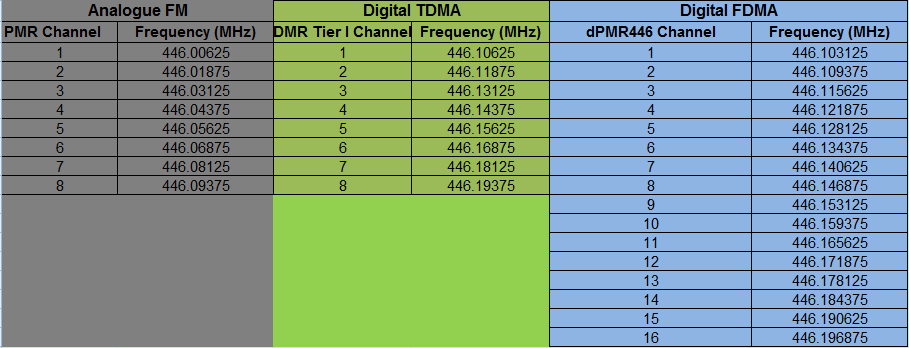PMR Radio and PMR446
09 Aug. 2016 Information
Private Mobile Radio (PMR) - sometimes called Professional Mobile Radio - was developed for business users who need to keep in contact over relatively short distances with a central base station / dispatcher - a typical example is a taxi company. PMR is also widely used by emergency services. PMR networks consist of one or more base stations and a number of mobile terminals. Such a system serves a closed user group and that is normally owned and operated by the same organization as its users.
From their early designs, PMR systems have developed into 'trunked' systems, the most notable of which is TETRA, Terrestrial Trunked Radio. Trunking is a technique where the resources of the communications network are shared, thus providing both flexibility and economy in the allocation of network resources. Typically, a communication channel is allocated for the duration of a call and then automatically released to allow it to be used for another call, perhaps between different users on the same system. The technique also enables multiple base stations to be connected and to provide coverage across a wider area than with a single base station.
PMR systems generally provide facilities for closed user groups, group call and push-to-talk, and have call set-up times which are generally short compared with cellular systems. Many PMR systems allow Direct Mode Operation in which terminals can communicate with one another directly when they are out of the coverage area of a network.
PMR systems may also be developed to allow public access (by subscription), and they are then known as Public Access Mobile Radio (PAMR). The users of PAMR systems are usually not the same as the system's owner and operator. Traditionally, PMR systems have usually been based on European standards for the equipment, but operated under licence and subject to National frequency management plans. An exception is PMR 446 such as
HQT QM-446 and
TH-446PLUS.
What is PMR446?
PMR446 (personal mobile radio, 446 MHz) is a part of the UHF radio frequency range that is open without licensing for business and personal use in most countries of the European Union. (It has roughly the same use as FRS or GMRS in the United States and Canada.) Depending on surrounding terrain range can vary from a few hundred metres (in a city) to a few kilometres (flat countryside) to many kilometres from high ground. It is ideal for small-site, same-building and line of sight outdoor activities. PMR446 is used in both professional and consumer-grade walkie-talkies (similar to those used for FRS/GMRS in the United States and Canada).
Commonly the definition of a PMR446 radio is a transceiver which transmits between 446.0–446.1 MHz and digital dPMR/DMR cover 446.1–446.2 MHz. Until recently, PMR446 radios were handheld radios with fixed antennas. In November 2015, Midland Radio announced the release of the GB1 mobile PMR446 radio for vehicular use.
Communication Range
The range of PMR446, just like any VHF or UHF radio, is dependent on many factors like environment (in-city range is far less than in an open field), height above surrounding obstructions, and, to a lesser extent, weather conditions. The antenna type and location, transmit power and receive sensitivity also affect range. However, with PMR446 most of these variables are fixed at manufacturing to comply with the PMR446 specifications. Most of the time the maximum range that a user in a city can expect is a few hundred metres or less.
Range may be many kilometres, for example between hilltops, or only a few hundred metres, if for example a hill or large metal object is in the transmission path between radios. The best known long distance record is 333 mi (535.8 km) from Blyth in the United Kingdom to Almere, Netherlands. This was the result of enhanced propagation conditions, not a line-of-sight signal.
Analogue FM VS Digital FDMA VS Digital TDMA
(Source: the PMR Radio part is from www.etsi.org and the PMR446 part is from wikipedia)
